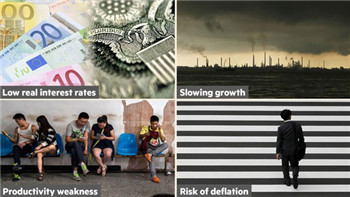(单词翻译:单击)

The volatility in China’s equity and currency markets in the first week of 2016 was reminiscent of August 2015, but more serious.
中国股票和外汇市场在今年第一周的动荡让人想起2015年8月的情景,但情况更严重。
Even though the Chinese equity market doesn’t matter that much fundamentally to China or to the global economy, financial policy and the drip-feed depreciation of the renminbi matter a lot. There is a rising anxiety about the credibility of policymakers and regulators, and about the state of the economy, the reform agenda and now a looming credit crisis.
中国股市对中国或全球经济都没有多大根本性影响,但中国金融政策和人民币的逐渐贬值影响很大。政策制定者和监管者的公信力、经济状况、改革议程、还有日益迫近的信贷危机都让投资者越来越感到焦虑。
Even though December’s early readings for both manufacturing and services were disappointing, infrastructure and other policy support programmes have helped moderate the downtrend in growth. The beleaguered real-estate sector has experienced higher sales, even higher prices, in large cities, and some tumbling industrial indicators have stabilised. Yet we should not be distracted.
尽管12月制造业和服务业活动的初值均令人失望,但基础设施和其他政策支持计划帮助缓和了经济增长的下行趋势。在不景气的房地产行业,大城市出现销量上升、甚至房价上涨。一些大幅下滑的工业指标企稳。然而,我们不应被这些分散掉注意力。
The year-end Central Economic Work Conference agreed an implicit 6.5 per cent economic growth target, supported “as necessary” by accommodative fiscal and monetary policies. Neither the state of the economy nor the country’s politics suggest much will be done.
年底的中央经济工作会议定下了没有言明的6.5%经济增长目标,“必要时”会以积极财政政策和宽松货币政策来支持这一目标。无论从经济状况来看,还是从国内政治形势来看,都应该不会采取大量举措。
Reforms to the real economy and state monopolies have stalled, or succumbed to pushback. Policies designed to develop new sectors have not been matched by those needed to tackle problems in larger ones, such as overcapacity. Tellingly, China’s most serious problem — relentless debt accumulation — received passive attention at most.
对实体经济和国有垄断企业的改革已经停滞,甚至被迫后退。虽然出台了发展新兴产业的政策,但缺乏解决规模较大行业存在的产能过剩等问题所需的政策。很突出的一点是,中国最严峻的问题——债务持续累积——顶多受到被动注意。
The growth in Chinese non-financial debt has been analysed since the 2008-09 bank lending stimulus programme. It has risen from about 100 per cent to about 250 per cent of gross domestic product but, far from slowing down with the economy, the pace of debt accumulation has picked up in the past one to two years. Total social financing, a broad measure of monthly credit creation, is growing at nearly three times the rate of officially recorded money GDP growth, or more if you don’t believe the official GDP data. Curiously, many private companies face tight credit conditions, so rapid credit creation may be largely for the benefit of the cash-flows of the highly indebted real-estate sector, local governments and state enterprise sectors.
自2008/09年借助银行放贷的刺激计划推出后,中国非金融债务的增长就是一个分析对象。非金融债务与GDP的比例从100%左右升至约250%,但近一两年来,债务累积速度非但没有与经济同步放缓,反而有所加快。社会融资规模(衡量月度信贷创造的广义指标)的增速是官方名义GDP增长率的近三倍——如果你不相信官方GDP数据的话,那就不止三倍了。奇怪的是,很多民营企业面临信贷紧张状况,因此,快速的信贷创造可能主要流向严重负债的房地产行业、地方政府和国有企业主导行业。
Some financial policies have been introduced by way of countermeasures, but to little effect. For example, the government clamped down in 2013 on borrowing by local government financing vehicles, only to relax the curbs last year. It also introduced a local government bond debt-swap scheme last year to allow expensive bank debt to be exchanged for cheaper debt instruments. Banks duly bought more than Rmb3tn of bonds, but traditional lending growth continued regardless.
作为对策,一些金融政策陆续推出,但收效甚微。例如,政府在2013年禁止地方政府融资工具借款,但去年又放松了限制。去年政府出台了一项地方政府债券债务转换计划,允许将昂贵的银行债务置换为更廉价的债务工具。银行购买了规模适中的逾3万亿元人民币债券,但传统贷款仍然任性地持续增长。
After encouraging the development of shadow banking between 2009 and 2013, lending restrictions were enforced in 2014, but a fall in financial institutions’ off-balance sheet assets simply showed up in an expansion in the main banking system’s assets.
继2009年至2013年期间鼓励影子银行业发展,政府于2014年对该领域实施放贷限制,但金融机构表外资产规模下降的同时,主要银行业体系的资产出现扩张。
Although government officials speak occasionally of the need to allow corporate defaults and restructuring, and recognise bad debts in the banking system, political and institutional blockages to such outcomes are formidable.
尽管政府官员有时也会讲,有必要允许企业违约和重组,有必要承认银行体系中的坏账,但政治和制度阻力巨大,难以出现这种结果。
Instead, all we are likely to see is more credit easing, in the wake of the six initiatives since late 2014 to cut interest rates and banks’ reserve requirements, albeit to no economic effect. The credit binge, then, will go on until it can’t.
相反,我们可能看到更多信贷宽松举措出炉。自2014年末以来,当局已6次采取降准降息举措,只不过对经济毫无效用。信贷热潮还将持续下去,直到无法持续。
Decisive factors will be the compromised debt-servicing capacity of borrowers, and the behaviour of banks under the weight of rising non-performing and bad loans and emerging funding difficulties as loan-to-deposit ratios increase further.
决定性因素有两点,一个是借款者已减弱的偿债能力;第二个是在贷存比进一步上升之际,背负着不良贷款及坏账上升和出现新融资困难的压力,银行会有什么行为。
It is in this context that we might reflect on the announcement of a $512bn fall in currency reserves in 2015. Since China has a current account and net direct investment surplus of about $600bn, implied capital outflows must have been close to $1tn. Some of this was capital flight. Given the interplay between capital flight, a more uncertain “managed” currency depreciation and a private credit binge that’s going in the wrong direction, China’s credit crisis may be approaching just that little bit faster.
在这种背景下,我们来思考一下2015年中国外汇储备减少5120亿美元这一消息的含义。中国拥有约6000亿美元的经常账户和净直接投资盈余,因此资本流出规模应该接近1万亿美元。其中一些是资本外逃。考虑到三个方面——资本外逃、更加不确定的“有管理”的货币贬值,以及沿着错误方向发展的私营部门信贷热潮——的相互作用,中国的信贷危机或许略微加快了脚步,正在不断逼近。
George Magnus is an associate at Oxford university’s China Centre and senior economic adviser to UBS
乔治氠格努斯(George Magnus)是牛津大学(Oxford University)中国中心(China Centre)研究员、瑞银(UBS)高级经济顾问


